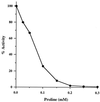Cloning of a polycistronic cDNA from tomato encoding gamma-glutamyl kinase and gamma-glutamyl phosphate reductase
- PMID: 9223347
- PMCID: PMC21589
- DOI: 10.1073/pnas.94.15.8249
Cloning of a polycistronic cDNA from tomato encoding gamma-glutamyl kinase and gamma-glutamyl phosphate reductase
Abstract
We isolated from a tomato cDNA library the tomPRO1 locus, which encodes gamma-glutamyl kinase (GK) and gamma-glutamyl phosphate reductase (GPR). This locus is unusual among eukaryotic genetic elements because it contains two open reading frames, and thus resembles prokaryotic polycistronic operons. The first open reading frame, specifying GK, is terminated by a TAA codon, which is followed by five nucleotides, an ATG translation initiation codon, and the second open reading frame, encoding GPR. DNA sequence analysis of fragments obtained by PCR amplification confirmed that the internal TAA and neighboring sequences are present in the endogenous tomPRO1 sequence in tomato. We demonstrated with RNase protection assays that the tomPRO1 locus is transcribed in tomato tissue culture cells, into a product that contains the internal stop codon. In Escherichia coli, tomPRO1 directed the synthesis of two proteins, a 33-kDa GK and a 44-kDa GPR. Antibodies against the 44-kDa GPR purified from E. coli recognized a 70-kDa product in tomato tissue culture cells and a 60-kDa product in leaves and roots. These results suggest that in tomato tissues, GPR is made as part of a longer polypeptide by some translational mechanism that enables bypass of the internal stop codon, such as frameshifting or ribosome hopping. The tomPRO1 locus may be the first example of a nuclear genetic element in plants that encodes two functional enzymes in two distinct open reading frames.
Figures





References
-
- Yancey P H, Clark M E, Hand S C, Bowlus R D, Somero G N. Science. 1982;217:1414–1422. - PubMed
-
- Brown A D. Microbial Water Stress Physiology: Principles and Perspectives. Chichester, U.K.: Wiley; 1990.
-
- Jeffries R L. In: Genetic Engineering of Osmoregulation: Impact on Plant Productivity for Food, Chemicals, and Energy. Rains D W, Valentine R C, Hollaender A, editors. New York: Plenum; 1980. pp. 135–154.
-
- Stewart C R. In: The Biochemistry of Drought Resistance in Plants. Paleg L G, Aspinall D, editors. Sydney: Academic; 1981. pp. 243–259.
-
- Leisinger T. In: Escherichia coli and Salmonella typhimurium: Cellular and Molecular Biology. 2nd Ed. Neidhardt F C, Curtiss R III, Ingraham J L, Lin E C C, Low K B, Magasanik B, Reznikoff W S, Riley M, Schaechter M, Umbarger H E, editors. Washington, DC: Am. Soc. Microbiol.; 1987. pp. 434–441.
Publication types
MeSH terms
Substances
Associated data
- Actions
- Actions
- Actions
- Actions
LinkOut - more resources
Full Text Sources
Other Literature Sources

